Trending
Opinion: How will Project 2025 impact game developers?
The Heritage Foundation's manifesto for the possible next administration could do great harm to many, including large portions of the game development community.

Featured Blog | This community-written post highlights the best of what the game industry has to offer. Read more like it on the Game Developer Blogs or learn how to Submit Your Own Blog Post
Motivation differences between male and female gamers who identify as "hardcore". This is based on our dataset from over 350,000 gamers.

In our talk at GDC 2018, we explored what gamer motivations would look like if we defined “casual/core/hardcore” gamers using different assumptions—e.g., by self-identification with labels vs. by gaming frequency vs. by specific game titles they play. In this blog post, we’ll focus on the slice by self-identification with labels, but we’re hoping to cover at least one additional slice in a future post.
At Quantic Foundry, our Gamer Motivation Profile allows gamers to take a 5-minute survey to get a personalized report of their gaming motivations, and see how they compare with other gamers. Over 350,000 gamers worldwide have taken this survey. The 12 motivations that are measured in our model were identified via statistical analysis of how gaming motivations cluster together. You can get a more detailed description of our gamer sample here.
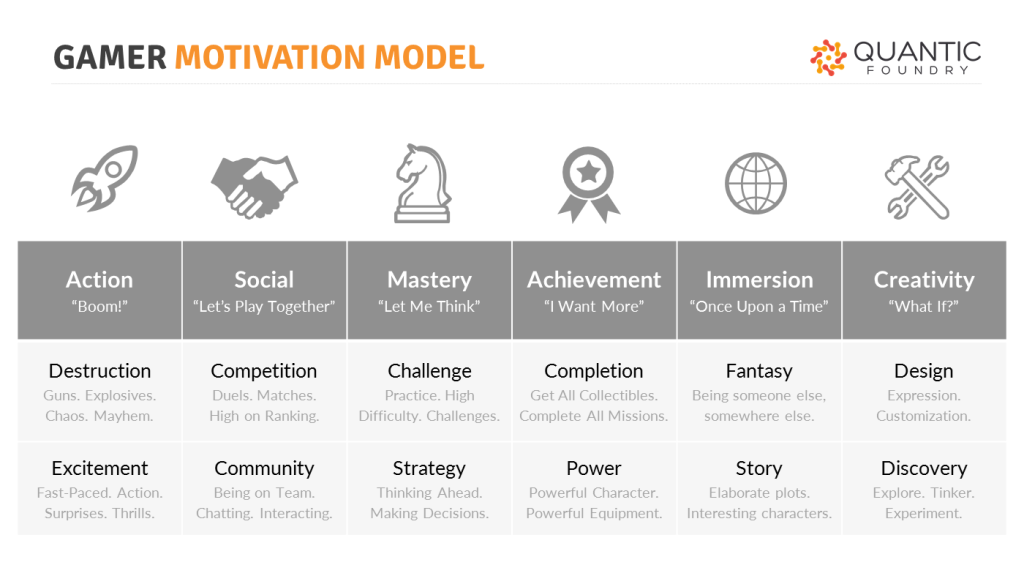
In the survey, here’s how we asked gamers about their self-identification with gamer type labels:
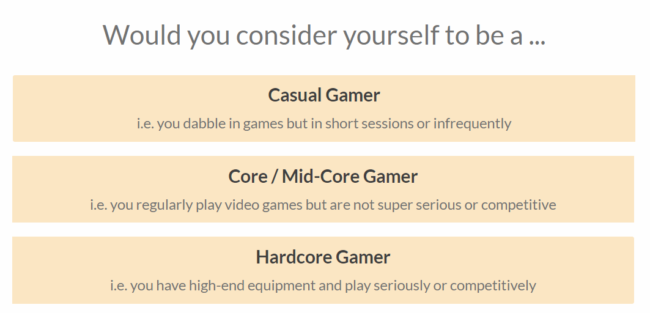
Note that there isn’t a standardized definition of these terms in the gaming community, and without some guidelines around what these terms mean, the results would have been difficult to interpret. This was the rationale behind providing a loose definition that blended frequency with dedication for each label. We’re definitely not claiming these are the only possible definitions, or that our definitions are great, but it provides a working foundation from which to make sense of the findings.
In our full dataset, 68% identify as core, 21% as hardcore, and the remaining 10% as casual. 79% identify as male, 19% identify as female, and the remaining ~1.5% identify as non-binary/other.
In this chart below, the y-axis is showing the percentile rank of each motivation. That 50th-%tile line represents the average among the 350,000+ gamers who have completed the Gamer Motivation Profile. So for example, the 74th-%tile in Competition among Hardcore gamers means that the average Hardcore gamer scores higher on Competition than 74% of the gamers in the full data set.
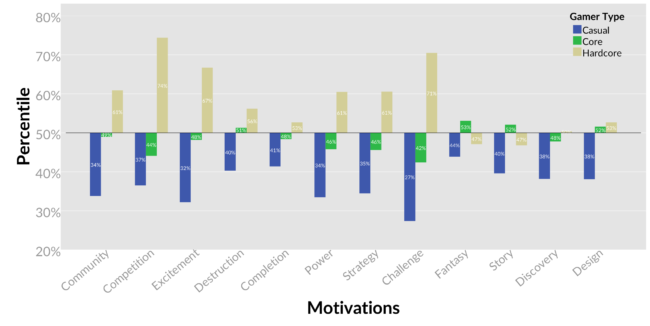
Hardcore gamers are most different from Casual gamers in terms of Competition (duels, matches, leaderboard rankings), Challenge (practice, skill improvement, high difficulty), and Excitement (fast-paced, thrills, surprises)—they are looking for fast-paced, skill-based matches against other players. Casual gamers, on the other hand, are looking for calm, non-adversarial games that are easy to learn and play.
Completion (collecting collectibles, completing all the missions) and Fantasy (being someone else, somewhere else) vary the least among the gamer types. In this sense, these two motivations are orthogonal to what is considered Casual vs. Hardcore. Or put another way, these are the things that both Casual and Hardcore gamers can often agree upon, which is something we don’t usually consider because we tend to focus on how different Casual gamers must be from Hardcore gamers.
And it also provides a basic recipe for how to enable coexistence. You create a common area based on task-completion in a moderately-immersive world, and then you provide separate optional lanes for fast-paced, competitive content and calm, solo content. Note how this model is very much the route that most MMOs have taken.
When we focus on just the Hardcore gamers (10% of female gamers and 24% of male gamers in our sample) and break down the data by gender, we see that the overall emphasis on Competition/Challenge/Excitement is driven by the male gamers—these 3 motivations are the primary drivers among male Hardcore gamers. Female Hardcore gamers, while scoring above average in these 3 motivations are more strongly driven by Design (expressing individuality, customization) and Completion.
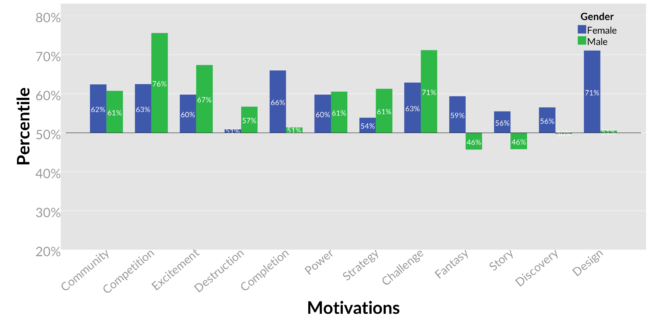
So for men, playing a game seriously means being able to beat other players at it. For women, playing a game seriously is more likely to mean having completed and done everything there is to do in a game, and to leave traces of your personal flair in the game while doing it. For Hardcore female gamers, playing a game seriously is more akin to patiently creating and curating a work of art. And it’s a powerfully evocative alternative to how we typically conceptualize what a “hardcore gamer” is.
This gender comparison between Hardcore and Casual gamers also highlights the difference in coverage of different motivations: Male Hardcore gamers are below average in Fantasy (being someone else, somewhere else) and Story (elaborate plot and interesting characters), whereas female Hardcore gamers are consistently above average across all gaming motivations.
Thus, for men, being Hardcore is more about specializing into competitive gaming, whereas for women, being Hardcore is more about developing a broad interest in all aspects of gaming.
Let’s flip this around and look only at Casual gamers (21% of female gamers and 9% of male gamers in our sample). Gamers who identify as Casual are less enthusiastic about every gaming motivation across the board. So this is why almost all the bars are below the median line.
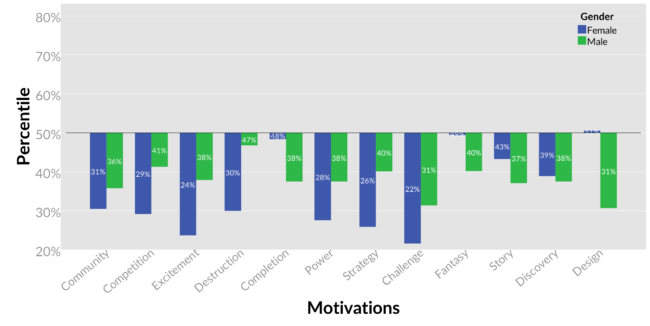
Casual male gamers score highest on Destruction (guns, explosives, chaos). For them, casual gaming means blowing things up and leaving behind a trail of chaos and mayhem. Note how the things important to Hardcore male gamers—Competition, Challenge, and Excitement—are now deemphasized among Casual male gamers.
For women on the other hand, casual gaming looks a lot like the markers for Hardcore female gamers. We see Design and Completion along with Fantasy. Casual female gamers like being teleported to another world with task completion and customization opportunities.
Our goal in this post was not to define what “Casual/Core/Hardcore” mean—that’s a much bigger discussion around the intersection of gamer preferences and game mechanics/complexity. We were more interested in exploring what “hardcore” and “playing seriously” means for gamers who ascribe to different gamer type labels (as one of many possible ways of slicing the data).
The two main takeaways are that 1) Hardcore female gamers have different motivational drivers than Hardcore male gamers, and 2) Hardcore is more about breadth for female gamers and more about specialization for male gamers.
The gaming community tends to define Hardcore using the male gamer lens, so there’s inevitably a tautologous conclusion that male gamers are more likely to be Hardcore. But this leads to distortions in making sense of actual gaming behavior. For example, in a study of 7,000+ EverQuest 2 players that my colleagues and I conducted, we found that female MMO gamers spent more hours playing per week and were less likely to consider quitting. But ironically, it was precisely the most frequent and loyal gamers who got stereotyped as being “casuals”.
What’s clear is that we need to be constantly exploring different lenses for understanding player categories and identifying potential fault-lines between our assumptions and gamer data.
Check out our blog for more data-driven articles on video game and board game audiences and their gaming motivations.
Read more about:
Featured BlogsYou May Also Like